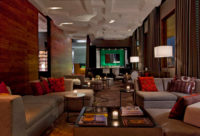China confounds our Western guilt with its ambitious Expo 2010.
How could any building be higher? How could any development be larger? Have we gone as far as we can go? We seem to have reached a limit this year with the completion of the Burj Khalifa, in Dubai, U.A.E. — featured in this issue — which scrapes the heavens at 828 meters (2,717 feet). While beautifully realized, it calls into question the basic programmatic decisions of the forces that conceived it. The Burj culminates an era of financial expansion worldwide, yet opened, ironically, in the aftermath of an economic free fall.

CityCenter, meanwhile, rises in another desert, a world away. This urban agglomeration of more than 18 million square feet, the largest privately funded development in the United States, combines a cosmic gathering of talent in a multibillion-dollar mashup that warrants our critical attention: Was it worth the effort? Ironically, MGM Resorts International reached out to the investment company Dubai World to help fund these ambitious hanging towers. But to what avail?
Heroic in scale and scope, both projects were born in prosperity but have appeared in a new, scorched age: Like starlight, they shed heat and light separated from us by time and space. Today’s fragile world, with its dwindling resources and expanding populations, is calling for other agendas in the West. Attribute it to changing fortunes or the bitter aftertaste of spilled oil, our architectural sights have now shifted to a more socially, environmentally conscious agenda. We’re imagining a smaller scale, hands-on, ecofriendly urban world. We have corrected course from too much bigness. Right?
But whoa! Just at the moment that we Westerners have admitted our collective guilt, here comes the rest of the world, China in particular, loudly singing, “We’ve Only Just Begun.” Along with the Beijing Olympics of 2008, Expo 2010, in a staggering debut, announces in capital letters that China has arrived on the world stage. Perhaps more than the Olympics, this world’s fair, set in Shanghai, consumes a massive investment — $45 billion — more than Beijing spent on the games.
The exposition spans both sides of the Huangpu River with a positive theme of “Better City, Better Life.” While world’s fairs have been ignored in the West, devolving into nonevents (who can recall a single structure from Hanover’s in 2000?), they still retain the potential for signifying a nation or a city on the rise: Think London in 1851 or Chicago in 1893. China understands the branding opportunities.
The Shanghai Expo defies expectations, stretching for 2.04 square miles. Both entertainment and urban development, the fair reclaims a formerly gritty industrial area, changing wasteland into parkland and factories into exhibition halls and gathering places. One quadrant of the Expo, entitled “Urban Best Practices,” showcases good ideas for a sustainable future with pavilions from international cities, such as a geothermally cooled house from Hamburg, Germany, that brings cooling to the sultriest day like an ice cream cone. Feel-good and do-good meets good times.
Some improvements will stick. Five major pavilions constructed by the Chinese, including the signature red China Pavilion and space-age arena, will remain after the fair as the centerpiece of a large urban park that will serve as a site for future meetings and trade shows. At the same time, the nation invested in the city. Permanent improvements include the construction of a new freeway and five(!) new subway lines since 2006 (fully functioning, clean, easy to navigate). Such accomplishments humble us.
Country pavilions, which draw the crowds, include representatives from the nearly 190 nations that wanted to be on the guest list at China’s biggest party. Despite a disappointing showing from the United States, two of the best, Great Britain and Spain, represent architecture by two of those respective nations’ most talented designers: Thomas Heatherwick and EMBT. Korea’s and Denmark’s pavilions also beckon.
The imaginative designs — Britain’s houses a genetic treasure house of seeds, a so-called “seed cathedral,” from Kew Gardens, and the expressionistic Spanish pavilion is covered in wickerwork — demonstrate that creativity and inventiveness are flourishing, while the U.S. contribution seems like a sad version of corporate fulfillment.
The crowds are coming. Chinese television posts each day’s turnstile figures, which sometimes top 500,000 in a single day. Lines are prodigious, often requiring several hours’ waiting in the steamy heat for a single pavilion; Saudi Arabia’s alone, the most expensive on the site, takes upwards of nine hours to enter and navigate. Estimates place ultimate attendance north of 70 million people by the time the Expo closes on October 31. Meanwhile, the city of Shanghai, more vibrant than any world’s fair, with more tall buildings than its closest rival, continues to swell and grow upwards, with skyscrapers sprouting from the World Financial Center to the forthcoming Shanghai Tower, emerging from the Pudong muck.
Attitude adjustment is in order: From Dubai, U.A.E., to Dubai World in Nevada, we might congratulate ourselves, knowing that we have neatly figured out how the world should operate and build. If we think we’ve reached some kind of outer limit in Dubai and Nevada, that today’s architectural ambitions and goals have shrunk down to manageable size, to the comfortable anti-icon, we may need to think again. Yes, we’ve scraped the heavens. The Expo demonstrates that other nations have their own ideas and are matching their urban visions to reflect their arrival on the world’s stage. Today, it’s China’s turn.
If you wish to write to our editor-in-chief you can email him rivy@mcgraw-hill.com.



Post a comment to this article
Report Abusive Comment